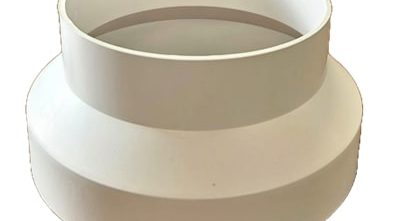In many ventilation and extraction systems, it’s not unusual to encounter components with different connection sizes. A rigid plastic reducer offers a straightforward way to adapt those diameters without compromising airflow.
The versions we supply are available in three popular transitions:
These reducers are used across a range of applications, including bathroom and utility room ventilation, whole-house systems, HVAC, heat recovery units, and air conditioning ducting. Their smooth internal profile helps minimise air turbulence, which is especially important in longer duct runs or where airflow efficiency is a priority.
A quick, reliable way to adapt ducting sizes
The design is lightweight but durable, manufactured from flame-retardant polymer for safety and compliance. Each reducer is male-ended, meaning the larger side fits directly into female rigid ducting without the need for an extra connector. For the smaller side, especially when connecting to a fan spigot or fitting, it can be useful to add a short length of matching duct to achieve a flush, clean fit.
Where and how they’re used
Rigid reducers are generally preferred over trying to force flexible ducting to fit mismatched sizes. The smooth-walled construction offers superior airflow performance, and the solid build maintains its shape, making it suitable for both DIY and trade installation. They’re also easy to handle on-site, can be cut if necessary, and provide a much neater finish, particularly in visible or plant room installations.
When using a reducer to connect two lengths of rigid ducting, simply slip the straight pipe over the reducer and secure. As with all duct fittings, keeping the larger duct diameter for as much of the run as possible will help maintain airflow efficiency, with the size reduction positioned closer to the outlet or equipment connection point.
Technical Note on Airflow and Reducer Sizing
The airflow capacity of a round duct is determined by its cross-sectional area, so reducing diameter will inevitably affect the volume of air that can move through it.
- 150mm to 125mm – Approx. 30% reduction in cross-sectional area; minimal impact in short runs but can increase static pressure in long ducting.
- 150mm to 100mm – Nearly 50% reduction; suitable for short runs or where the fan/system is designed for 100mm ducting.
- 125mm to 100mm – Around 36% reduction; commonly used for smaller extract systems where high flow rates aren’t required.
Best practice is to minimise the number of diameter changes in a single run and to keep the reduced section as short as possible. Where performance is critical, check the fan’s performance curve to ensure it will still deliver the desired airflow after the reduction.
Key Takeaway:
Reducing duct size will always create some airflow loss. A 150mm to 100mm step-down almost halves the available cross-sectional area, so keep this change as close as possible to the outlet or connection point to minimise performance impact.
Written by Enya Kerry – Office Manager at Ducting Express
With over four years of industry experience and W201 and P601 certifications, I’ve helped countless customers select the right duct fittings for their systems. If you’re unsure which reducer will give the best results for your setup, I can help you make the right choice.
